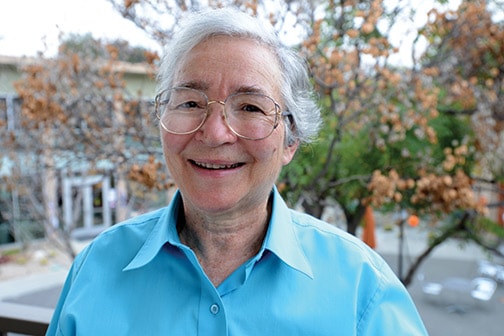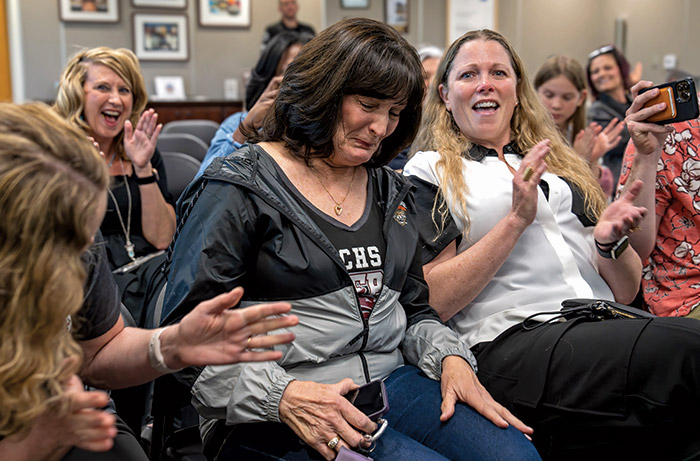Former Pitzer professor promoted better understanding of math

by Mick Rhodes | mickrhodes@claremont-courier.com
Math: it’s a dirty word to some, a source of endless fascination to others. Members of the former camp might well have been convinced otherwise if only they had benefitted from a thoughtful math education, says Judith Grabiner, who clearly knows of what she speaks.
The 51-year Claremont resident spoke to the COURIER on the occasion of her latest accolade, being awarded the 2021 Albert Leon Whiteman Memorial Prize from the 133-year-old American Mathematical Society.
The spirited and fascinating 82-year-old, who retired from Pitzer in 2014, won the prize for “her outstanding contributions to the history of mathematics, in particular her works on Cauchy, Lagrange, and MacLaurin; her widely-recognized gift for expository writing; and a distinguished career of teaching, lecturing, and numerous publications promoting a better understanding of mathematics and the significant roles it plays in culture,” according to the announcement from the A.M.S.
If you’re not a math historian, professor or aficionado, and don’t know influential 18th and 19th Century European mathematicians Cauchy, Lagrange and MacLaurin from John, Paul, George and Ringo, don’t sweat it; Ms. Grabiner is about as far as one can imagine from an elitist when it comes to explaining the history of mathematics.
She conveys her deep understanding of the historic underpinnings of modern mathematics with disarming conversational ease. She’s has a way of explaining concepts that left this math-phobic college dropout feeling downright optimistic about the subject.
“We’ve been reading your little newspaper since we moved to Claremont in 1971,” Ms. Grabiner said when she spoke to the COURIER in March.
For the better part of the 40 years since, she and her husband Sandy Grabiner, who was Pomona College’s Joseph N. Fiske Professor of Mathematics prior to his 2014 retirement, have been a Claremont mathematics power couple.
Ms. Grabiner’s approach throughout her teacher career was to focus on her students’ passions, and then help them find the math in those things, turning the experience into something that informed their everyday lives.
“I had one student who said, quite frankly, ‘I’m only in this course because they’re making me take a math course,” Ms. Grabiner said. “I hate mathematics and I’m not interested in it at all, and the only thing I really, really care about is my off campus activity. I work a homeless shelter in the city.’ And I said, ‘How many homeless people are there in the United states?’ She said, ‘I don’t know.’ I said, ‘Do you think that’s an important question?’”
She turned on the switch for the student, who set upon digging up mounds of research.
“She got interested in the question because she cared about it, and she gave a really, really excellent report.”
Ms. Grabiner was born in Los Angeles in 1938. She earned her bachelor’s degree in mathematics in 1960 at The University of Chicago, her master’s in 1962 from Radcliffe, and a PhD in the history of science in 1966 from Harvard.
She married husband Sandy Grabiner in 1964. A decade later he took a job as a mathematics professor at Pomona College, a job he held for 40 years before retiring in 2014. The couple have two children who both attended Claremont High School: David, a mathematician for the federal government, and Rebecca, Senior Class Dean at Barnard College in New York City.
Ms. Grabiner began her teaching career at UC Santa Barbara, then moved on to California State University, Los Angeles before taking a professorship at California State University, Dominguez Hills, where she received the school’s outstanding professor award in 1975. She joined the mathematics department at Pitzer College in 1985, and was named the Flora Sanborn Pitzer Professor of Mathematics in 1994.
Prior to her 2016 retirement, she won numerous awards for her extensive writings in mathematics journals and magazines, and authored three books, 1981’s The Origins of Cauchy’s Rigorous Calculus; The Calculus as Algebra, in 1990; and in 2010, A Historian Looks Back: The Calculus as Algebra and Selected Writings, which won the Mathematical Association of America’s Beckenbach Book Prize in 2014.
She’s been invited to speak at conferences the world over, and her widely praised Teaching Company course, “Mathematics, Philosophy, and the ‘Real World,’” has been used in countless math classrooms. Since her retirement she’s been serving as a volunteer math tutor with the Claremont After School Program.
Printed in full, Ms. Grabiner’s many other notable accolades and accomplishments would frankly fill the space we have for this story.
The Grabiners’ are a longtime mathematical force in a town full of forceful academics. She is quick to point out though that she is a math historian, not a mathematician.
“You don’t have to be an artist to appreciate the history of art,” Ms. Grabiner said. “And you don’t have to be an English person to appreciate the history of England. And you don’t have to have been a member of some oppressed group to learn from the history of an oppressed group. History helps you understand stuff. And what I would say to people who have been mathematically mistreated, I apologize on behalf of the whole profession.”
Her enthusiasm hasn’t waned after more than six decades of advocacy, study, writing, lecturing and teaching. Her informed criticisms of American math education are equally passionate.
“We teach math at a speed that leaves not the majority of students behind, but enough students behind, that they never catch up,” she said when asked why so many students despise math. “Because if you can’t add, then you can’t multiply. And if you can’t multiply, you can’t divide. And if you can’t divide, then you can’t do fractions. And if you can’t do fractions, there’s an awful lot of higher mathematics that is completely closed to you.
“Sometimes people get to college and there’s something from way back that they didn’t get, and they’re sitting in calculus class and they can’t do the calculus. And they’re thinking, ‘This person’s supposed to be a really great teacher, but I’m just not getting it.’ And if you can identify what it is that they didn’t get, by sort of going back down the tree. But that takes time and that takes one-on-one instruction. I wish that our educational system was set up to do that for all students, and we’re clearly not.”
For those skeptics who feel mathematics have no bearing on their lives, Ms. Grabiner has this advice:
“Look for mathematics in your own life. If you want to learn more mathematics, that’s the place to start. There you are in the kitchen trying to divide a recipe that is for six people and you want to cook it for two. How do you do that? And if you cook, you care about that. If you don’t cook, then you don’t.”
@font-face {font-family:”Cambria Math”; panose-1:2 4 5 3 5 4 6 3 2 4; mso-font-charset:0; mso-generic-font-family:roman; mso-font-pitch:variable; mso-font-signature:-536870145 1107305727 0 0 415 0;}@font-face {font-family:Calibri; panose-1:2 15 5 2 2 2 4 3 2 4; mso-font-charset:0; mso-generic-font-family:swiss; mso-font-pitch:variable; mso-font-signature:-536859905 -1073697537 9 0 511 0;}@font-face {font-family:Times; panose-1:0 0 5 0 0 0 0 2 0 0; mso-font-alt:Times; mso-font-charset:0; mso-generic-font-family:auto; mso-font-pitch:variable; mso-font-signature:-536870145 1342185562 0 0 415 0;}p.MsoNormal, li.MsoNormal, div.MsoNormal {mso-style-unhide:no; mso-style-qformat:yes; mso-style-parent:””; margin:0in; mso-pagination:widow-orphan; font-size:12.0pt; font-family:”Calibri”,sans-serif; mso-ascii-font-family:Calibri; mso-ascii-theme-font:minor-latin; mso-fareast-font-family:Calibri; mso-fareast-theme-font:minor-latin; mso-hansi-font-family:Calibri; mso-hansi-theme-font:minor-latin; mso-bidi-font-family:”Times New Roman”; mso-bidi-theme-font:minor-bidi;}a:link, span.MsoHyperlink {mso-style-priority:99; color:#0563C1; mso-themecolor:hyperlink; text-decoration:underline; text-underline:single;}a:visited, span.MsoHyperlinkFollowed {mso-style-noshow:yes; mso-style-priority:99; color:#954F72; mso-themecolor:followedhyperlink; text-decoration:underline; text-underline:single;}.MsoChpDefault {mso-style-type:export-only; mso-default-props:yes; font-family:”Calibri”,sans-serif; mso-ascii-font-family:Calibri; mso-ascii-theme-font:minor-latin; mso-fareast-font-family:Calibri; mso-fareast-theme-font:minor-latin; mso-hansi-font-family:Calibri; mso-hansi-theme-font:minor-latin; mso-bidi-font-family:”Times New Roman”; mso-bidi-theme-font:minor-bidi;}div.WordSection1 {page:WordSection1;}








0 Comments